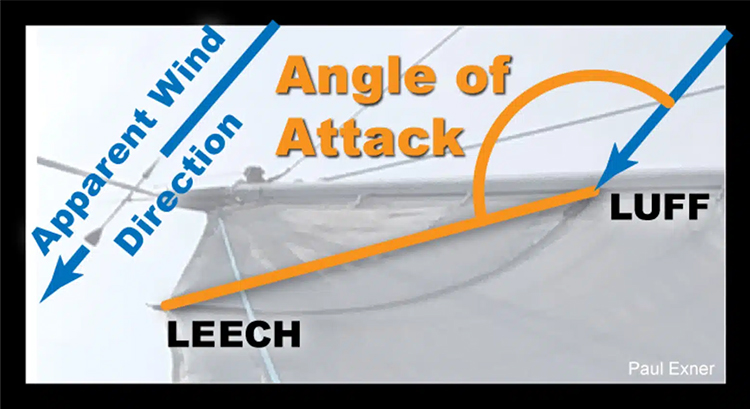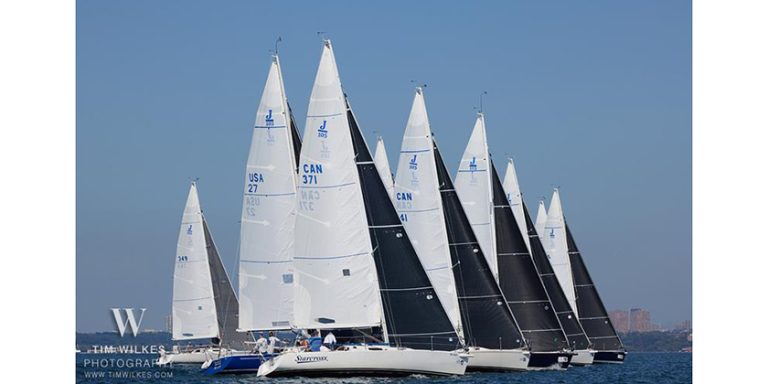Mastering Apparent Wind

September 20, 2023
By Paul Exner for UK Sailmakers
Expert and novice sailors alike use apparent wind. Many sailors believe apparent wind is unworthy of deep consideration and take it for granted because they feel they’ve already grasped the concept. Although its fundamentally simple, apparent wind is dynamically complex in practice.
Apparent wind is the most important factor affecting a sailboat in motion. Apparent wind is elusive, it changes constantly as we sail; it’s the throttle by which we sail. Mastering the triggers that control apparent wind will unlock your sailing potential more than any other thing you can pay attention to. Today’s tips help you visualize apparent wind and break down how to use it.
TIP 1: LEARN TO RECOGNIZE THE FEELING OF APPARENT WIND
A sailor continuously senses the apparent wind on their face and feels the hull sailing beneath them. In simple terms: the apparent wind is the wind experienced by an observer in motion and is the relative velocity of the wind in relation to the observer.
To best appreciate the relationship between apparent wind and your boat’s performance, you must mentally record the physical changes in apparent wind and boat performance over time. Focus on this relationship in 30-second intervals (or longer) to enhance your understanding. This could take you a lifetime to master.
TIP 2: UNDERSTAND THE THEORY OF APPARENT WIND
The classical theory defines the velocity of apparent wind as the vector sum of the velocity of the headwind (the wind velocity a moving object would experience in still air) plus the velocity of the true wind.

Headwind is defined by a boat’s speed and direction, taking into consideration factors such as leeway, wave resistance, current, and other motions such as rolling and pitching.
Despite its simple definition, apparent wind changes constantly and rapidly in the real world.
TIP 3: HARNESS APPARENT WIND
The wind blows over a sail’s surface, but the only thing that allows power to be created from a sail is its angle of attack. The angle of attack is determined by both the craft’s point of sail and how the sail is oriented with respect to the apparent wind. A sail’s angle of attack is the angle between the sail’s chord line (between the luff and leech) and the direction of the apparent wind.

You are responsible for the apparent wind you have, and you can influence your apparent wind vector by understanding how to control it. Subtle directional changes in relation to the true wind can have a significant impact on boat speed, in part due to the immediate changes in apparent wind.
When you’re sailing and turn toward the true wind, your apparent wind speed immediately increases; conversely, if you turn away from the true wind, the apparent wind immediately decreases. Knowing when to seek more (or less) apparent wind is a more complex concept.
TIP 4: UNDERSTAND THE POWER OF APPARENT WIND IN THE LIFT EQUATION
Sail Power (formally: Lift) is influenced MORE by apparent wind than anything!
Sail Power is a function of four notable factors:
Lift(f) = Sail Area; Sheet Angle; Sail Shape; V^2
Where, Apparent Wind = V
Sail Power varies to the SQUARE of Apparent Wind: V^2
To generate lift, a sail must present an “angle of attack” between the chord line of the sail and the apparent wind velocity.
The Lift Equation reveals it all — never underestimate anything that varies quadratically!

You can (and should) control your sail-power by coaxing a little more or less apparent wind! This is simply true because sail-power responds to the square of apparent wind speed. For example, if you coax your apparent wind from 8 to 9 knots because you’re a skilled sailor, you gain 8% more sail power! When the true wind is this light, an 8% increase makes the difference between keeping your boat moving or coming to dead-stop.
TIP 5: OPTIMIZE SAIL POWER
A boat’s hull is designed to perform within a narrow range of sail power. Frankly, the sailor’s job is to continually supply and drive the hull with the right amount of sail power. Sail area and sheet angle offer the foundation for sail power, but it’s the apparent wind flowing over the sail that offers throttle control. It’s imperative that a sailor optimizes the proper apparent wind across a sail to give the hull its power to keep the boat within its control specifications.
Aero/Hydro balance is designed into every boat. More power than necessary doesn’t create incremental improvements to performance — in fact, incorrectly powered sailboats are more difficult to manage; and, the risks of component failure in overly powered situations are greater than any perceived efficiency gains.
You can sense your boat’s balance given the apparent wind you’ve created and the sea state you’re sailing through. Unfortunately, I cannot offer specifics about how to get the most from this tip because this art requires intuition based on knowledge and experience. However, as you’re now equipped with my concept — it works; now, go practice!
















